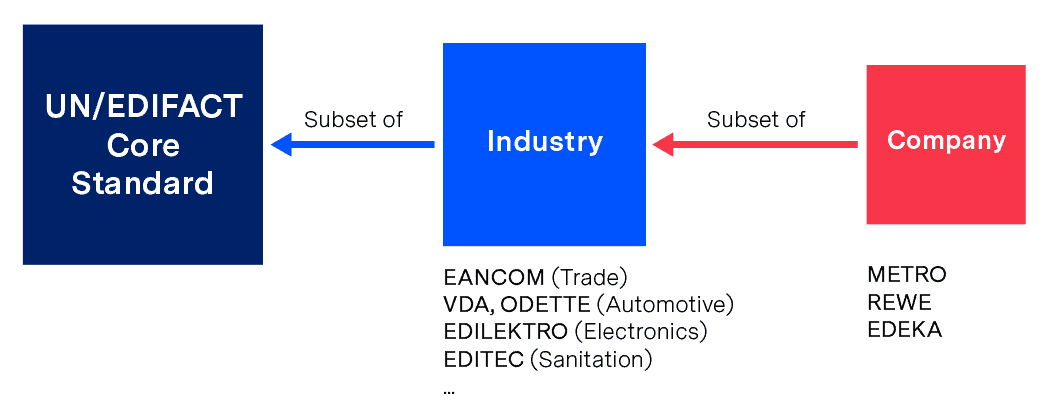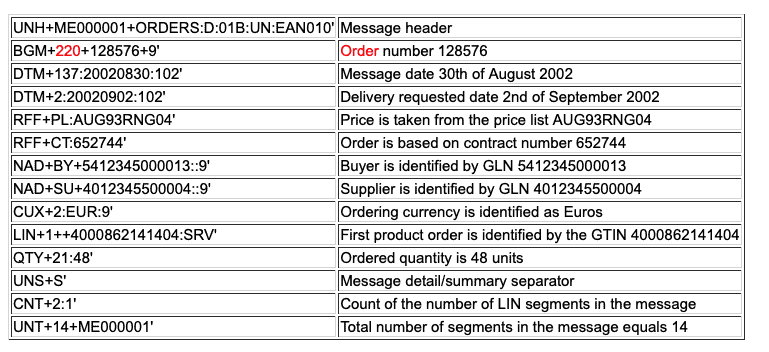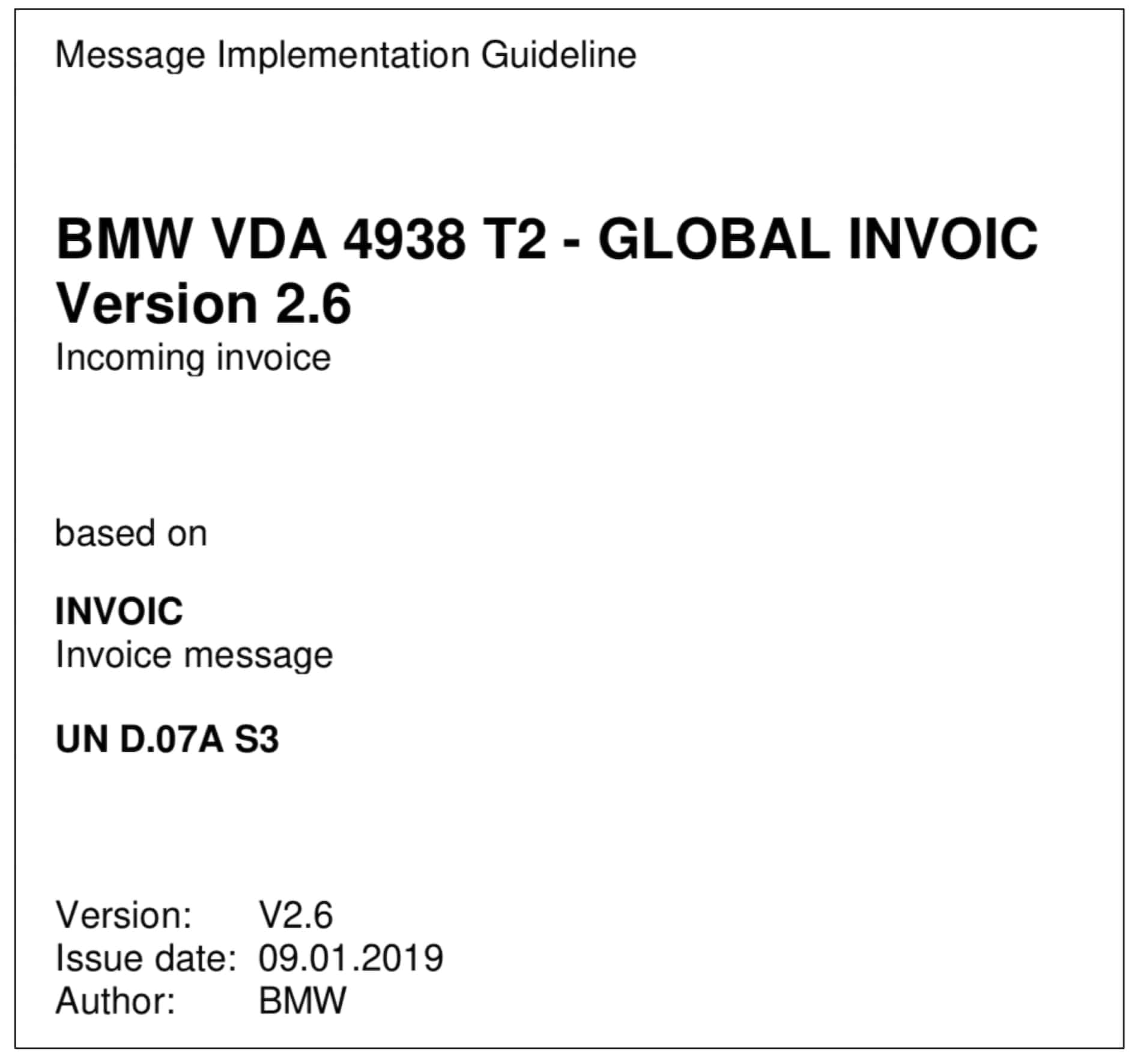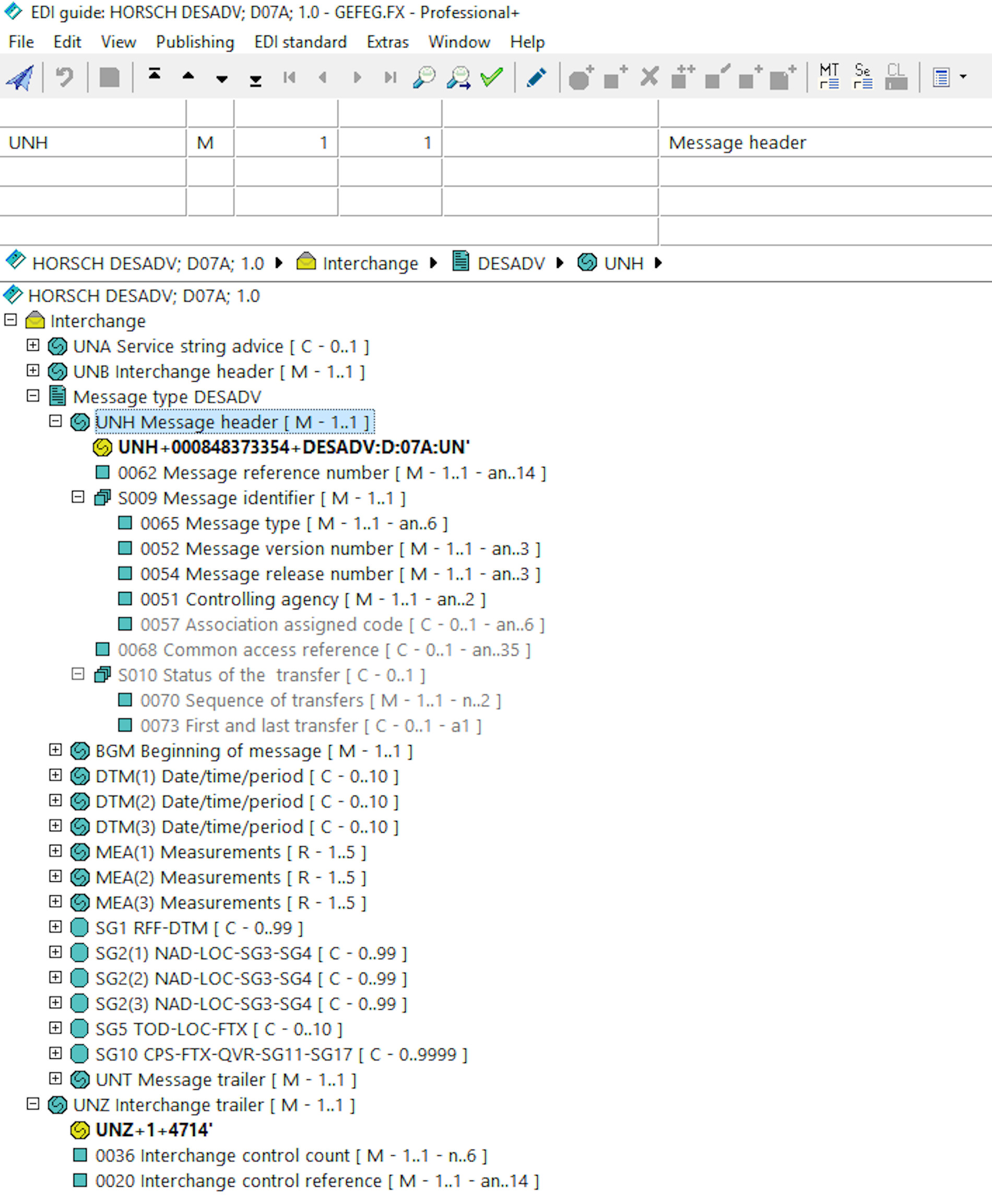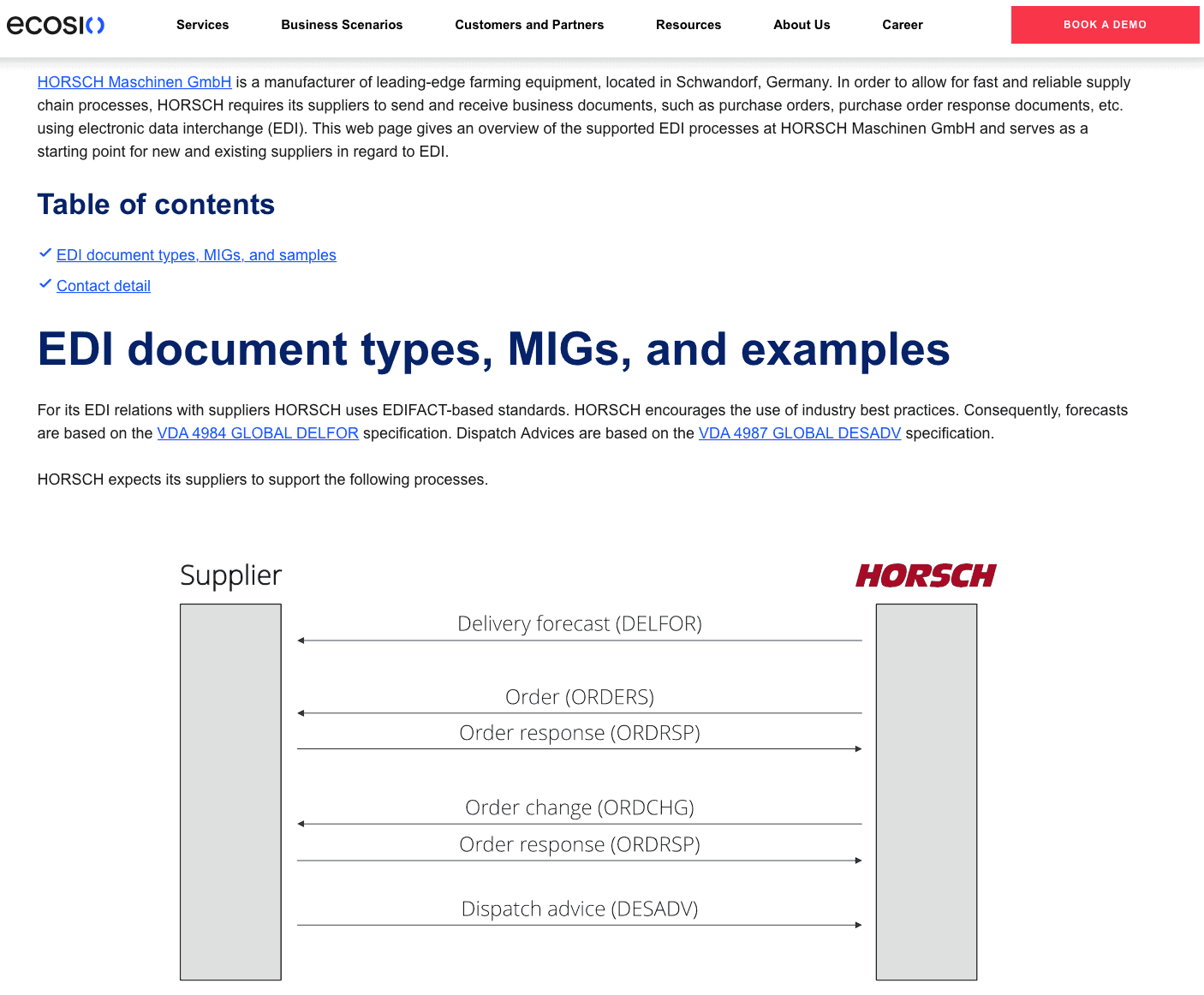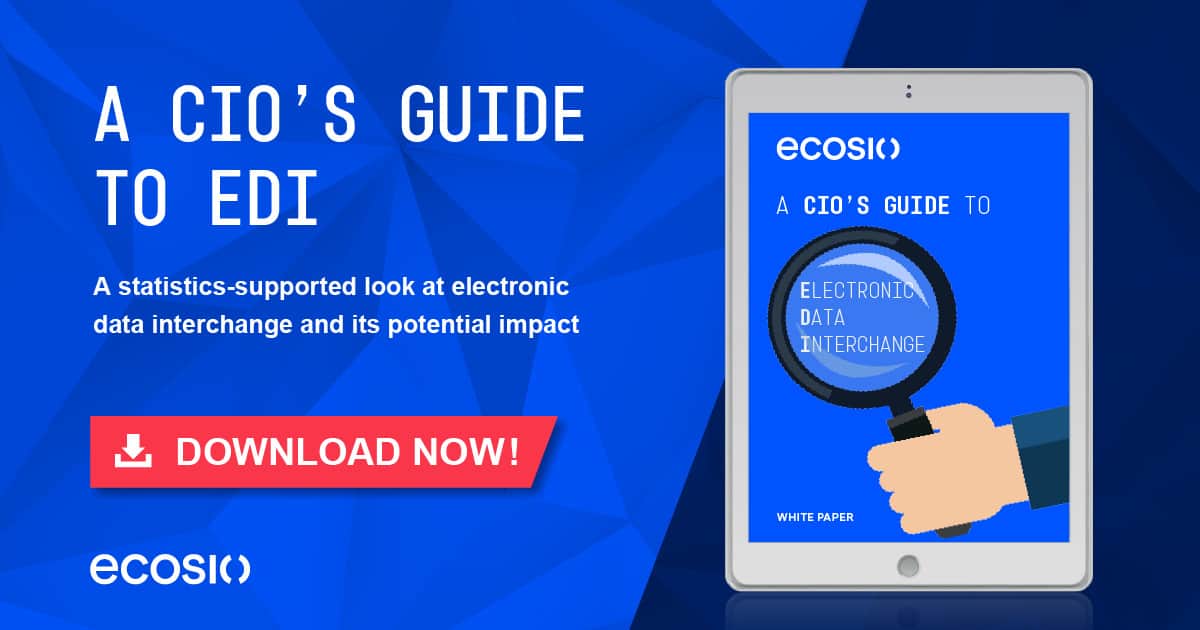Background: MIG and EDI
Today, standards based on UN/EDIFACT, ANSI ASC X12 or XML are primarily used for the exchange of EDI messages. A Message Implementation Guideline (MIG) refines a generic EDI standard such as UN/EDIFACT (Electronic Data Interchange For Administration, Commerce and Transport) and limits it to use in specific domains or companies. UN/EDIFACT is developed by the United Nations and is the most widely used EDI standard in the world, along with the North American ANSI ASC X12 format.
UN/EDIFACT contains various requirements from different application areas, which makes the standard very extensive. To make working with UN/EDIFACT clearer, different EDIFACT subsets have been developed that are adapted to different industries. For example, EANCOM was created in the retail sector, VDA in the automotive industry, EDILEKTRO in the electrical industry and EDITEC in the HVAC and plumbing sector. These subsets are refinements of the UN standard, in which, for example, permissible code values as well as obligatory fields are defined. Based on these sub-formats, many companies have in turn developed their own versions.
In order for business partners to be able to conduct EDI, the document structures must be implemented on the basis of the partner’s MIGs at the beginning of a cooperation.
A MIG can only tighten up a standard, which means that, for example, no new elements may be added. However, elements can be set to “mandatory” or “not used”. As shown in the following diagram, the basis of all derivatives of EDIFACT standards is the UN/EDIFACT standard. Subsets for different industries are derived from this standard. Companies then use these subsets to create their own variants.
Various industries and companies create subsets of the UN/EDIFACT standard
For the refinement of the standard, own codes are used, which are mostly listed at the beginning of a MIG in the footer of the document. The following excerpt shows the breakdown of codes for a MIG from EDEKA.
Description of the codes used in the EDEKA ORDERS MIG
M indicates that the specification is mandatory and C marks a segment/element as optional. D means that the use of the segment/element is dependent on the use of another segment/element. The dependency is usually explained in the explanatory text. X means that a certain segment/element is not used.
Structure of a Message Implementation Guideline (MIG) using EDIFACT ORDERS
In the consumer goods industry, the EDIFACT subset EANCOM of GS1 is mostly used. EANCOM reduces the UN standard to the most important fields that are obligatory in trade and comprises about 50 different message types. One of these message types is ORDERS – a Purchase Order, which is sent by a customer to a supplier to order products/services.
The following figure shows an excerpt of an EANCOM EDI ORDERS guideline.
Restricting the possible codes for a document to a discrete set of allowed values in EDEKA’s MIG
As can be seen, the use of the data element 1001, for example, is restricted to a list of permissible values. Without this restriction, all values from the general UN/EDIFACT standard could be used.
The EANCOM Message Implementation Guideline for ORDERS can be viewed online and can also be used as a reference for developing your own subset. In addition, the various segments and their meaning in the message structure can also be viewed there.
All permissible codes and their meaning are also broken down here. The graphic representation of the message structure (a so-called branching diagram) and a list of business terms are further important components that are helpful in the implementation of the MIG.
An EDIFACT ORDERS message consists of three parts:
- The header, in which the business partner, delivery conditions, payment conditions, etc. are listed.
- The item part, in which the GTIN, as well as the quantity and price of the ordered items are indicated.
- The total part, which contains the number of item lines of the message.
The ORDERS message for a normal order can look like the one shown in the left column of this graphic:
We have already presented the exact structure of an EDIFACT ORDERS message in detail in a previous article.
Advantages of using Message Implementation Guidelines
As mentioned at the beginning, the exchange and implementation of message implementation guidelines is particularly relevant for the connection of suppliers. Typically, in trade and in the automotive industry, the guidelines are specified by the buyer. This means that suppliers usually work with many different subsets of the UN/EDIFACT standard and have to implement them.
The following figure shows a section of the MIG for the message type INVOIC of the company BMW AG.
MIG for the EDI document type INVOIC from BMW
As a supplier to the automotive industry, all MIGs of the different automotive customers have to be supported. Although these are often based on the same EDI standard (mostly VDA), they often differ in terms of structure and filling.
How do I get a Message Implementation Guideline?
If a company wants to create its own MIG, all the necessary data of the various processes must first be collected. For example, what data does the ERP system need to process orders, delivery notes, invoices, etc.?
After defining which fields the different document types need, the guideline can be created. However, these are not written in a program such as Word, but use software developed specifically for this application. An example of this is the desktop application GEFEG.FX, which considerably simplifies the creation of a MIG for the various EDI message types. The following screenshot shows the interface of the GEFEG software:
User interface of the GEFEG.FX software
The software is used to load a basic standard (e.g. EANCOM) and then to refine this standard. For example, optional fields (C – conditional) are set to required (R – required). Segments that are not required are deleted. At the same time, the individual segments are backed up with sample data, which helps the reader’s understanding.
Afterwards, the finished Message Implementation Guideline can be exported from GEFEG.FX as a Word document or PDF. To make it easier for suppliers to access this document, it is a good idea to create a separate portal page on the Internet. Employees of the IT team or the partner’s EDI service provider are thus able to download the required documents and implement the document structures using the MIGs. Furthermore, it is advisable to also provide suppliers with sample files for the different formats and application scenarios.
Companies can also hire an EDI service provider to draft and create the Message Implementation Guidelines, as well as to provide a portal page. For example, the EDI document types and MIGs used by HORSCH can be viewed and downloaded on a dedicated website.
Summary
Message Implementation Guidelines specify how EDI documents must be structured so that the recipient can process them. This can reduce errors during data exchange and speed up processes.
If you want to develop your own guidelines, they can be created with the help of special software (e.g. GEFEG FX).
Got any questions?
Still have questions about EDI Message Implementation Guidelines? Contact us or use our chat – we are always happy to help!
Are you aware of our free XML/Peppol document validator?
To help those in need of a simple and easy way to validate formats and file types, from CII (Cross-Industry Invoice) to UBL, we’ve created a free online validator. Try out our free Peppol tool for yourself.


